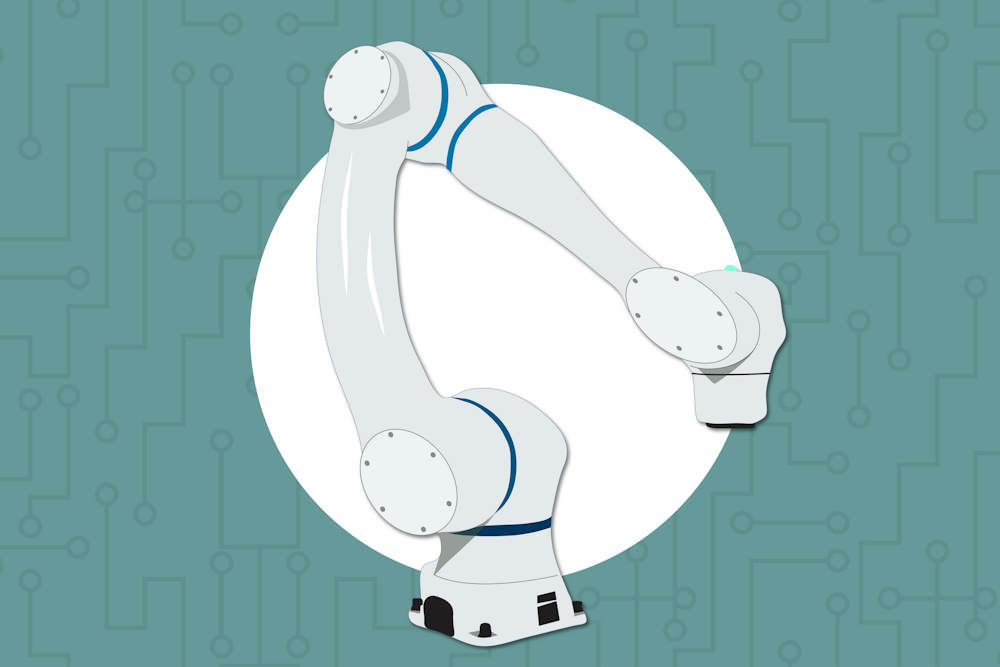The age old question of whether machines will replace humanity — a question popularized by films such as "The Terminator" and "The Matrix" — may have an answer at USC's McNAIR Center, where students are working alongside robots designed to collaborate with humans.
The McNAIR Center is researching how collaborative robots, called "cobots," can work and improve a variety of industries, said John Ward, USC's industry solutions consultant in the office for innovation, partnership and economic engagement.
"A lot of people get scared that robots are replacing people, but these are actually working alongside people to make their job easier and help them be more successful," Ward said.
The versatility of cobots, which were introduced to the McNAIR Center in 2017, lies within its hardwired sensors and safety measures that typical robots lack. Having sensors in the cobots means they can be programmed to assist humans in workspaces across different industries including automotive, aerospace and pharmaceutical, Ward said.
Yaskawa is the brand of robotic arm used in the McNAIR cobot research. The company's white robotic arms used for research are cobots, and their blue arms are standard robots without sensors. Since the blue robots at McNair don't have safety sensors, they require a glass cage surrounding the workspace to protect people from harm.
The difference with cobots is that a cage isn't required for the safety of people, but it is still present to ensure safety at the McNair Center. Cobots have sensors in place to make them safer. Both the white and regular blue robotic arms can perform and work together on the same programmed tasks.
If a person were to get in the way of a cobot, its hardwired sensors would stop the machine from moving as the person makes contact, preventing them from harm, but if someone were to get hit by a regular robot in action, it would cause a similar impact as getting in a car crash, Ward said.
Students working in the McNAIR Center can gain experience by coding and researching cobots and using both types of robots for small-scale assembly lines that model what is done in the manufacturing industry today, according to Ward.
“When they graduate, they actually not only have a theoretical (knowledge), but they have the practical knowledge of how to use the tools in the industry,” Ward said.

Cobots can also perform simpler tasks that require less extensive code, allowing the McNAIR Center to bring in younger students for training workshops, said Fadi El Kalach, a PhD student specializing in mechanical engineering.
“Right now, high schoolers, for example, have coding skills that I never used to learn when I was in high school, because technology evolves and things become more accessible,” Kalach said.
Ibrahim Yousif, a second-year PhD student specializing in mechanical engineering with a focus on smart manufacturing, said he has worked on making the cobots' interface more user-friendly, so that even a child could use it.
Bringing younger kids to work with cobots generates a lot of creative ideas because their imaginations run wild with how the cobots can be used, Yousif said.
Both Yousif and Kalach said they feel that cobots will change work environments involving manual labor for the better. Yousif said that cobots can enhance productivity for blue-collar workers because the interface is so user-friendly that they can operate them easily, and one person can accomplish more individually.
Cobots can make people's jobs easier when it comes to things like heavy lifting on an assembly line, said Ward.
"Cobots take away some of the repetitive processes from humans," Ward said. "The last thing you want to be doing is picking up a tire eight hours in a shift, and that's where a cobot can help out."
When a worker learns how to be a human machine operator, they'll have a more valuable skill set which could potentially make them more money, according to Yousif.
Noble Anumbe, USC's senior program manager of engineering and emerging technologies, does not think that new technologies will take away jobs for workers in the long run.
The initial prominence of the internet and email made people worried that postal office workers would become obsolete, in the same way that people in manual labor jobs might be worried about cobots, Anumbe said.
The internet did not take jobs away from the shipping industry but allowed it to flourish, leading to the rise of Amazon and FedEx creating a demand for shipping workers, Anumbe said. The same technology that causes people to worry about losing their jobs might end up creating more in the process, he said.
Kalach said he hopes that more students become exposed to cobots with the McNAIR Center workshops at a younger age, in order to advance what is already known about technology like cobots for generations to come.
"The more people that have access to these kinds of skills and experience, then the more advanced we can get," Kalach said.

